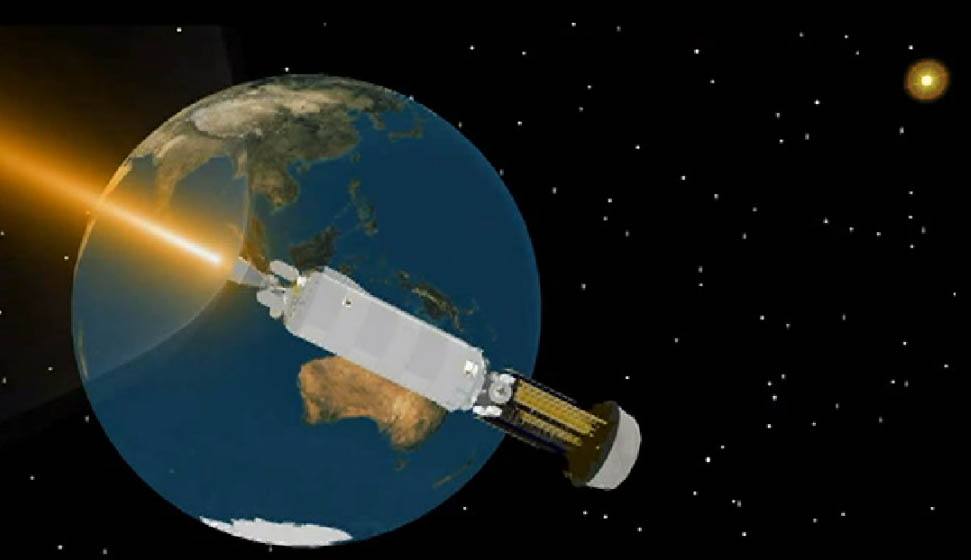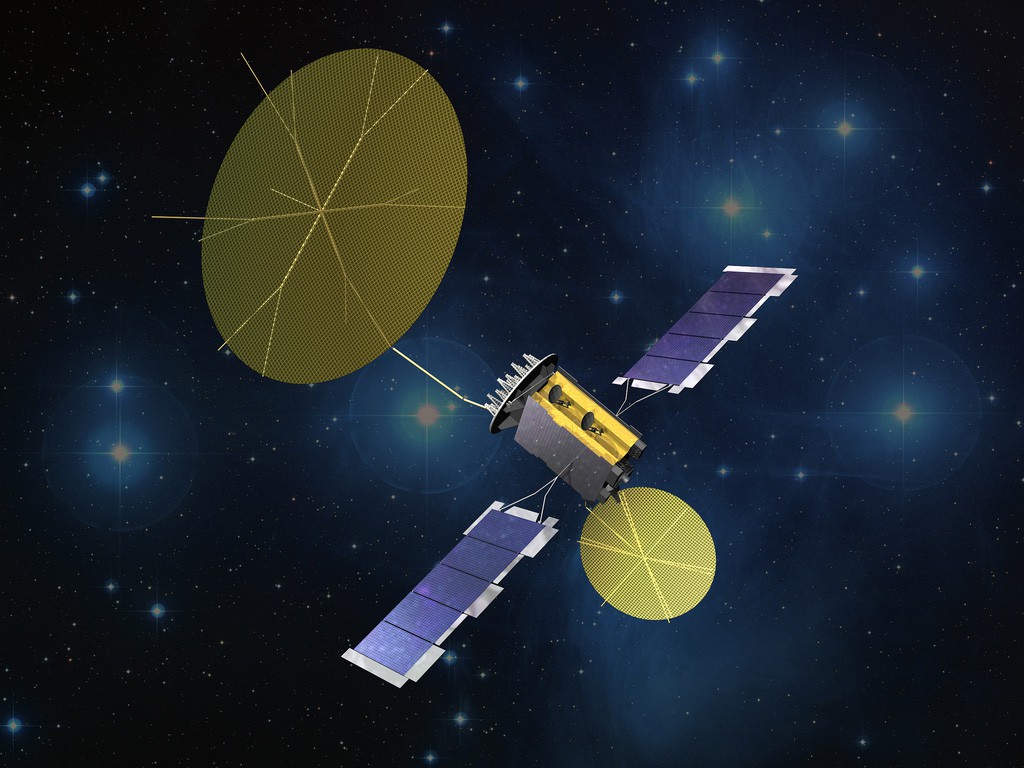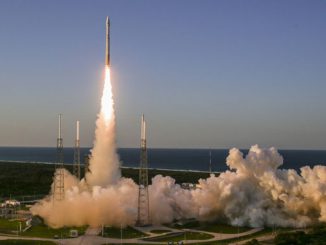
CAPE CANAVERAL — Likened to raising a cellular tower 22,300 miles high, a United Launch Alliance Atlas 5 rocket will put the Navy’s fourth mobile communications satellite into space Monday in a deployment that expands the rugged smartphone system to global coverage.
The predawn launch is scheduled for 6:07 a.m. EDT, providing an early sunrise for Florida’s Space Coast as the rocket departs Cape Canaveral’s Complex 41. The launch window extends to 6:51 a.m. EDT.
Rollout of the 206-foot-tall rocket from its assembly building to the launch pad is planned for Saturday morning and the countdown starts Sunday night.
Weather forecasters and mission managers continue to track the disorganized Tropical Storm Erika and a potential Florida landfall. Earlier predictions had the cyclone skimming the Cape as a hurricane, but the projected track has since shifted westward and that keeps the intensity down to tropical storm force.
“We do have a decision to make (Saturday) morning before roll, and we’ll have the latest information and forecast available to us….Based on what we’ve seen so far, the conditions are well within the vehicle’s capability and we’ll be proceeding,” said Jim Sponnick, ULA’s vice president for Atlas and Delta Programs.
“The Atlas 5 system was designed to safely withstand winds up to 50 knots or about 69 mph, which are just under those presented by a Category 1 hurricane….We have well-established procedures to secure the vehicle and our ground systems should the forecast worsen.”
Air Force meteorologists put the odds of acceptable launch conditions on Monday morning at 30 percent, with cloud cover and gusty winds the main concerns.
The Launch Readiness Review to clear the mission for flight occurred Friday after a rapid buildup of the rocket at the Vertical Integration Facility that began July 31.
Instead of stacking the interstage, Centaur upper stage and base sections of the nose cone individually, ULA mated those pieces together into a combined rocket section at a Delta 4 facility, saving a week of VIF processing time.
A beast of a rocket, the most powerful Atlas-Centaur currently available, will lift the 15,000-pound Mobile User Objective System satellite No. 4 into a high-perigee, geosynchronous transfer orbit. It takes three hours and three burns by the Centaur upper stage to get there.
“The MUOS satellites are the heaviest payloads to ride into space atop any of ULA’s Atlas 5 launch vehicles. The Atlas 5 generates more than two-and-half million pounds of thrust at liftoff in order to meet the demands of lifting the nearly 7.5-ton satellites,” Sponnick said.
In Atlas-speak, it is the 551-variant with five strap-on solid boosters and an 18-foot-diameter bulbous nose cone shrouding the Lockheed Martin-built satellite for atmospheric ascent.
Earlier launches of this energetic configuration sent NASA’s New Horizons to Pluto, the Juno orbiter to Jupiter and the three previous hefty MUOS satellites for the Navy.

A typical Atlas 5 launch to geosynchronous transfer orbit, the standard dropoff point for communications satellites, uses just two firings by the Centaur to achieve the highly elliptical, egg-shaped orbit to deploy the payloads. From there, the satellites use their own engines in the subsequent days to fly into the operational locations 22,300 miles above the equator.
But the sizable MUOS drove planners to create a three-burn launch profile for the payload to use all of the available performance from the Atlas-Centaur that in turns saves the satellite’s precious onboard fuel supply for maneuvering over its 15-year life.
The three burn mission design for MUOS provides 1,000 pounds greater lift capability than a conventional two-burn geosynchronous transfer orbit.
A preliminary parking orbit almost 400 miles high, tilted 28 degrees to the equator, is achieved just over 12 minutes into the launch as the Centaur shut down the engine and enters a brief cruise across the central Atlantic.
Just off the western coast of Africa, the Centaur main engine then restarts about 20 minutes after launch to propel MUOS to the second step on its way to the planned orbit. This six-minute burn puts the rocket into an elliptical 120 by 21,400 mile orbit inclined 26 degrees.
Then begins a lengthy coast away from the planet for two-and-a-half hours, flying to a point about 17,000 miles above the far eastern Indian Ocean where the final burn occurs.
One last push is given nearly two hours and 49 minutes into flight to raise the orbit’s low point and reduce the inclination closer to the equator. The burn, lasting a minute, places the payload into a 2,375 by 22,237 statute mile orbit at 19 degrees inclination.
The satellite separates from Centaur some two hours and 54 minutes after liftoff to complete the launch, the 56th for an Atlas 5 rocket and fifth of 2015.
The flight will be United Launch Alliance’s 99th since 2006 and the eighth this year.

This will be the second Atlas launch for the Navy in 2015, following MUOS No. 3 on Jan. 20 to cover the Atlantic Ocean region. MUOS 1 was launched Feb. 24, 2012 aboard an Atlas 5 and serves as the Pacific Ocean satellite. MUOS 2 launched July 19, 2013 aboard another Atlas 5 and serves as the continental U.S. satellite.
The Navy is fielding a constellation of four primary satellites and one in-space spare to cover the entire planet and provide 3G voice, data and video services to military troops on the move.
MUOS 4 will be parked in geosynchronous orbit 22,300 miles above the Indian Ocean to give the new communications system worldwide reach.
The final MUOS launch — the on-orbit spare satellite — is scheduled for July 2016 on Atlas. It, too, will be positioned over the Indian Ocean.
“Delivery of this fourth satellite for the U.S. Navy completes the initial MUOS constellation and provides near-global coverage for the network,” said Iris Bombelyn, vice president of Narrowband Communications at Lockheed Martin.
“For our mobile forces, that means for the first time they will be able to have secure, high-fidelity voice conversations, networked team calls and data exchange, including video, with anyone around the world connected with a MUOS terminal.”
The MUOS satellite’s communications payload features two gold mesh, umbrella-like antenna reflectors, one to provide the same type of UHF communications like previous Navy spacecraft and the other offering modernized capabilities that the new system will create.
Coverage to legacy users will transmit through a 17.7-foot-diameter reflector on the bottom of the MUOS craft and the advanced, multi-beam features of MUOS to significantly increase the transmission capacity over the Navy’s previous satellites will use a large 46-foot reflector atop MUOS.
The craft is solar-powered with wings that unfold in space to stretch 94 feet tip-to-tip.

All U.S. military forces rely upon Navy satellites for Ultra High Frequency narrowband communications. UHF offers small, portable units that forces can carry into battle and the frequency enables communications in urban canyons and mountainous terrain, penetrating foliage and transmitting through bad weather.
Each MUOS satellite has 16 times the capacity of the aging UHF satellite constellation.
“MUOS is a game-changer in communications for every branch of our military, which all have mobile users who will benefit from these new capabilities,” said Bombelyn.
See earlier MUOS 4 coverage.
Our Atlas archive.



